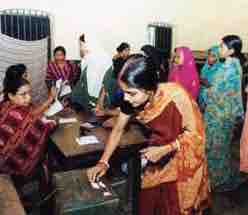Women's rights are entitlements and freedoms claimed for women and girls of all ages in many societies. In some places these rights are institutionalized or supported by law, local custom, and behavior, whereas in others they may be ignored or suppressed. The women's rights movement functions in response to an inherent historical and traditional bias against the exercise of rights by women and girls in favor of men and boys.
Women's suffrage in the United States was achieved gradually, at state and local levels, during the 19th century and early 20th century, culminating in 1920 with the passage of the Nineteenth Amendment to the United States Constitution. The amendment stated, "the right of citizens of the United States to vote shall not be denied or abridged by the United States or by any State on account of sex." Politicians responded to the newly enlarged electorate by emphasizing issues of special interest to women—prohibition, child health, public schools, and world peace. Women responded to these issues, but in terms of general voting, they shared the same outlook and the same voting behavior as men.
In the United States, the National Organization for Women (NOW) was created in 1966 with the purpose of bringing about equality for all women. NOW was one important group that fought for the Equal Rights Amendment (ERA). This amendment stated that "equality of rights under the law shall not be denied or abridged by the United States or any state on account of sex." But there was disagreement on how the proposed amendment would be understood. Supporters believed it would guarantee women equal treatment. But critics feared it might deny women the right be financially supported by their husbands. The amendment died in 1982 because not enough states had ratified it. ERAs have been introduced in subsequent sessions of Congress, but they have never been ratified.
While women are generally as likely to vote in developed countries, they are underrepresented in political positions. Women make up a very small percentage of elected officials, both at local and national levels. In the U.S., for instance, in the 109th Congress (2005-2007) there were only 14 female Senators (out of 100) and 70 Congressional Representatives (out of 435).

Voting Women
Women standing in line to vote in Bangladesh.